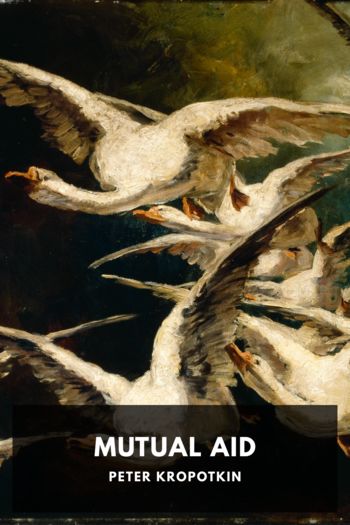Mutual Aid, Peter Kropotkin [fiction novels to read .txt] 📗

- Author: Peter Kropotkin
Book online «Mutual Aid, Peter Kropotkin [fiction novels to read .txt] 📗». Author Peter Kropotkin
Not long ago the small streams of Northern America and Northern Siberia were peopled with colonies of beavers, and up to the seventeenth century like colonies swarmed in Northern Russia. The flat lands of the four great continents are still covered with countless colonies of mice, ground-squirrels, marmots, and other rodents. In the lower latitudes of Asia and Africa the forests are still the abode of numerous families of elephants, rhinoceroses, and numberless societies of monkeys. In the far north the reindeer aggregate in numberless herds; while still further north we find the herds of the musk-oxen and numberless bands of polar foxes. The coasts of the ocean are enlivened by flocks of seals and morses; its waters, by shoals of sociable cetaceans; and even in the depths of the great plateau of Central Asia we find herds of wild horses, wild donkeys, wild camels, and wild sheep. All these mammals live in societies and nations sometimes numbering hundreds of thousands of individuals, although now, after three centuries of gunpowder civilization, we find but the debris of the immense aggregations of old. How trifling, in comparison with them, are the numbers of the carnivores! And how false, therefore, is the view of those who speak of the animal world as if nothing were to be seen in it but lions and hyenas plunging their bleeding teeth into the flesh of their victims! One might as well imagine that the whole of human life is nothing but a succession of war massacres.
Association and mutual aid are the rule with mammals. We find social habits even among the carnivores, and we can only name the cat tribe (lions, tigers, leopards, etc.) as a division the members of which decidedly prefer isolation to society, and are but seldom met with even in small groups. And yet, even among lions “this is a very common practice to hunt in company.”34 The two tribes of the civets (Viverridae) and the weasels (Mustelidae) might also be characterized by their isolated life, but it is a fact that during the last century the common weasel was more sociable than it is now; it was seen then in larger groups in Scotland and in the Unterwalden canton of Switzerland. As to the great tribe of the dogs, it is eminently sociable, and association for hunting purposes may be considered as eminently characteristic of its numerous species. It is well known, in fact, that wolves gather in packs for hunting, and Tschudi left an excellent description of how they draw up in a half-circle, surround a cow which is grazing on a mountain slope, and then, suddenly appearing with a loud barking, make it roll in the abyss.35 Audubon, in the thirties, also saw the Labrador wolves hunting in packs, and one pack following a man to his cabin, and killing the dogs. During severe winters the packs of wolves grow so numerous as to become a danger for human settlements, as was the case in France some five-and-forty years ago. In the Russian Steppes they never attack the horses otherwise than in packs; and yet they have to sustain bitter fights, during which the horses (according to Kohl’s testimony) sometimes assume offensive warfare, and in such cases, if the wolves do not retreat promptly, they run the risk of being surrounded by the horses and killed by their hoofs. The prairie-wolves (Canis latrans) are known to associate in bands of from twenty to thirty individuals when they chase a buffalo occasionally separated from its herd.36 Jackals, which are most courageous and may be considered as one of the most intelligent representatives of the dog tribe, always hunt in packs; thus united, they have no fear of the bigger carnivores.37 As to the wild dogs of Asia (the Kholzuns, or Dholes), Williamson saw their large packs attacking all larger animals save elephants and rhinoceroses, and overpowering bears and tigers. Hyenas always live in societies and hunt in packs, and the hunting organizations of the painted lycaons are highly praised by Cumming. Nay, even foxes, which, as a rule, live isolated in our civilized countries, have been seen combining for hunting purposes.38 As to the polar fox, it is—or rather was in Steller’s time—one of the most sociable animals; and when one reads Steller’s description of the war that was waged by Behring’s unfortunate crew against these intelligent small animals, one does not know what to wonder at most: the extraordinary intelligence of the foxes and the mutual aid they displayed in digging out food concealed under cairns, or stored upon a pillar (one fox would climb on its top and throw the food to its comrades beneath), or the cruelty of man, driven to despair by the numerous packs of foxes. Even some bears live in societies where they are not disturbed by man. Thus Steller saw the black bear of Kamtchatka in numerous packs, and the polar bears are occasionally found in small groups. Even the unintelligent insectivores do not always disdain association.39
However, it is especially with the rodents, the ungulata, and the ruminants that we find a highly developed practice of mutual aid. The squirrels are individualist to a great extent. Each of them builds its own comfortable nest, and accumulates its own provision. Their inclinations are towards family life, and Brehm found that a family of





Comments (0)